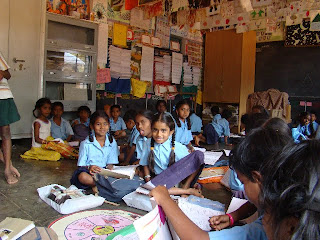 The opportunity to understand a little more about the famous prisoner 466/64 makes Robben Island a popular destination today.
The opportunity to understand a little more about the famous prisoner 466/64 makes Robben Island a popular destination today.As 50 of us tourists sat inside a prison in Section G, many were on their phones...tweeting what they heard, sharing what they saw and sending images to the rest of the world of their moving personal experiences.
Till 1991 - just 19 years ago, this was a maximum security prison known for its absolute and complete isolation of political prisoners of the Apartheid regime.
No information was allowed to leak out. Very little came in.
Nelson Mandela (466/ 64 - the 466th prisoner at Robben Island in the year 1964), spend around 16 years here, at the center of what would be South Africa's long and hard struggle for democracy and freedom from apartheid.
Today - we sat there communicating with the whole world. Each person in that room was writing, publishing, broadcasting through their mobile devices. In just 19 years so much has changed. This is the new text.
In a tour conducted by one of the ex-political prisoners, I had the opportunity to go inside the prison cells, walk the corridors and hear the stories of complete and total isolation. Of the atrocities only humans can bestow on fellow humans. And of how human dignity can still find ways to forgive.

Bereft of the tools for education, prisoners miraculaously found ways to convert the prison into a university - and the amazing process of Each One Teach One came into being. Popularly known as the 'Robben Island University' by the prisoners, they used every element of their spirit to over come the indignity of colour, separation, politics - and convert the subaltern text of imprisonment into learning.
Its amazing. Technology has changed the politics of freedom forever.
 In 2004 I had the opportunity to visit the Alcatraz, off the San Fransisco Bay. When the wind blew across the bay, you could hear voices carry over from the city into this maximum security prison that had housed many Civil War prisoners. Information, learning, knowledge and news - were all a premium. A privilege that was considered unnecessary .
In 2004 I had the opportunity to visit the Alcatraz, off the San Fransisco Bay. When the wind blew across the bay, you could hear voices carry over from the city into this maximum security prison that had housed many Civil War prisoners. Information, learning, knowledge and news - were all a premium. A privilege that was considered unnecessary .In 1997, I was an assistant director on one of the first film crews to be allowed to shoot in Kashmir. We shot on a few islands in the Dal Lake - islands that used to be the headquarters of the Hizbul Mujahideen. The site of many atrocities, these beautiful islands had seen so much struggle. We shot a docu-feature for the Home Ministry, stories that would build confidence and bring hope to the people of Kashmir.
The degree of despair in Srinagar in those years had amazed me. And as a film crew, we were a threat to many who saw news and information as a major de-stabiliser. Confirmed artists refused to act, under threat. And finally some CRPF personnel and 4 young surrendered terrorists became our key actors. The film ran on 'Doordarshan' - which for many years was the window to the world for India. Today of course, its irrelevant. There are over 250 channels on TV. Most of them with Breaking News every second.
Twitter, Facebook, SMSes, Mobiles have fundamentally changed our world. Made us free in such a different way. And it evolves every day.
Over 3 billion people have mobile phones across the world. 1000 new mobile customers are added every minute over the globe. Mobile internet is empowering Africa...
Inspiring organizations like Ushahidi have created platforms that allows people and communities to collate distributed data via SMS, email or web and visualize it on a map or timeline. A simple way of aggregating information from the public for use in crisis response. The people of Haiti have benefited tremendously from Ushahidi's innovation.
 Georeferencing, geotagging, visual mapping, community mapping.... all innovative applications of mobile technology that connect the world today in such incredible ways.
Georeferencing, geotagging, visual mapping, community mapping.... all innovative applications of mobile technology that connect the world today in such incredible ways.And yet there is the oppression in Afghanistan.
It gives us more reason to continue innovating. Finding more ideas that will link technology and freedom...















